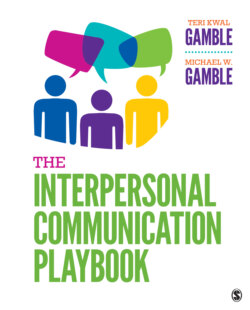Читать книгу The Interpersonal Communication Playbook - Teri Kwal Gamble - Страница 150
На сайте Литреса книга снята с продажи.
Chapter Summary
Оглавление1 Explain the nature of perception and its relationship to reality.□We do not all perceive reality similarly. Standpoint theory suggests that people in positions of power have an overriding interest in preserving their place in the social hierarchy. Thus, our view of reality is a consequence of the person we are, where we are, and what we choose to see. Perception is the personally based process we use to make sense of experience. When we perceive, we select, organize, and interpret sensory data in an effort to make sense of and give meaning to our world.
2 Describe the perception process in action.□Perception is a multi-stage process involving selection, organization, interpretation, remembering, and responding. We rely on a number of strategies to facilitate perceiving. The figure-ground principle addresses our tendency to focus on a particular person or item, while the surrounding context becomes background. Closure is the process we use to fill in missing perceptual pieces or gaps. Perceptual constancy is our tendency to maintain the way we see the world.
3 Explain how schemata, perceptual sets, unconscious bias, ethnocentrism, and stereotypes influence perception.□Schemata are cognitive frameworks, the mental templates or knowledge structures we carry with us. Perceptual sets are organizational constructions that influence our readiness to perceive in predetermined ways; each set or selectivity helps us decide what stimulus to focus on and how to construct our social reality. Unconscious bias is a prejudice we possess of which we are unaware. Ethnocentrism is the tendency to perceive right or wrong according to the values of one’s own culture. A stereotype is a rigid perception that is applied to an individual because of their membership in a particular group, regardless of individual variations.
4 Distinguish among the following perceptual barriers: fact-inference confusions, allness, indiscrimination, frozen evaluations, snap judgments, and blindering.□Each of these makes it difficult for us to perceive people and events accurately. Fact-inference confusions cause us to confuse observations and assumptions. Allness leads us to think we know it all. Indiscrimination causes us to emphasize similarities and neglect differences. When we make frozen evaluations, we ignore change. Snap judgments lead us to jump to conclusions. Blindering causes us to add restrictions where none actually exist.
5 Discuss how culture and gender influence perceptions of social experience.□Culture teaches us acceptable ways of looking at our world, as well as acceptable ways of behaving. Gender conditions men and women to perceive different realities, exhibit different behaviors, and use different communication styles.
6 Discuss how media and technology influence perceptions of social experience.□The media influence our self-perception, as well as our perception of each other and our social experiences. Because the media tend to reinforce cultural views of gender and ethnicity, they contribute to our becoming more accepting of social stereotypes. Technology is altering the way we perceive social connection, changing our view of what is real, and enhancing our perceptual acuity.
7 Identify strategies you can use to enhance your perceptual abilities.□To improve your chances of developing more accurate perceptions, you need to recognize the part you play in perception, develop patience, become a perception checker, see through others’ eyes, work to bridge perceptual differences, and carefully consider how technological innovations are affecting your perceptions.
